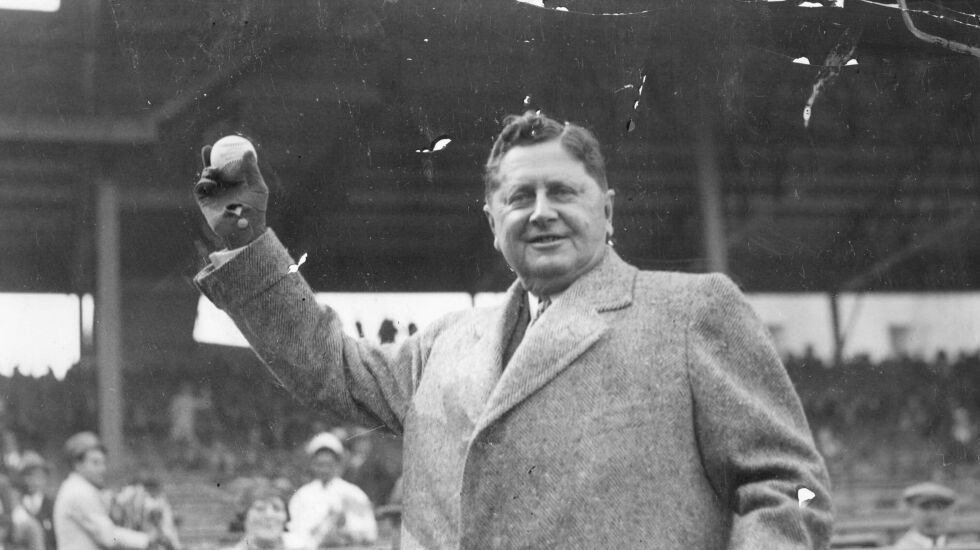
The Cubs game on April 14, 1925, a victory over the Pittsburgh Pirates, was the first major league game broadcast over Chicago radio. Big league baseball would become the most followed sport on radio, and it still is. One reason is that baseball’s deliberate pace allows the game’s best announcers to bond with their listeners, a flow that could be impeded by the new pitch clock’s faster pace.
Baseball broadcasters not only do great play by play, they also engage in baseball stories and homespun chat, painting word images that take audiences beyond the diamond to connect with sentimental memories. Chicago is blessed with a history of especially good broadcasters working Cubs and White Sox games, including today’s announcers.
Yet none of this would have happened the way it did without another Chicago connection: William Wrigley Jr.
Early baseball owners actually feared radio and rejected it. The New York owners even banned their home games from the airwaves for a five-year span in the 1930s. Most team owners thought no one would pay to attend games if they could hear the game for free at home.
The Cubs’ Wrigley, a natural marketer and innovative team owner, knew better.
Radio expands, baseball reinvents itself
The Roaring Twenties were the perfect time for baseball broadcasting, when Wrigley, Babe Ruth and radio all collided. America’s very first commercial broadcasting station was KDKA in Pittsburgh. Chicago’s first station, KYW, began broadcasting on Nov. 11, 1921.
From there, radio became widely commercialized, with over 500 stations operating nationally in 1922. By 1923, Chicago itself had at least 20 stations, including WMAQ, WBBM and WLS. KYW evolved into WDAP, then became WGN when it was bought by Col. Robert R. McCormick.
In those days, the major league game was also reinventing itself. In 1919, pitching phenom Babe Ruth slugged a whopping 29 home runs for the Boston Red Sox, nearly tripling his league-leading 11 from the year before. Red Sox owner and theatrical producer Harry Frazee won the World Series in 1918.
After that, the Red Sox faded, and Frazee sold Ruth to the Yankees, where Ruth smashed 54 homers in 1920 and 59 more the following year. He clubbed his season record 60 in 1927 for the famous “Murderers’ Row” Yankees. The long ball was on the map.
Meanwhile, Wrigley the promoter made his first fortune selling soap in Chicago for his father’s Philadelphia company. When he hustled his soap with a new premium item, chewing gum, it was such a hit that he dropped the soap and kept the Wrigley gum business.
At the same time, Wrigley believed radio would increase baseball attendance, not reduce it, and he was right. When the Cubs games began broadcasting in 1925, stadium attendance more than doubled. Why? A promotions phenomenon called “billboarding” was spreading the Cubs all over the city, expanding awareness and generating interest everywhere. More and more people wanted to see the game live at Wrigley Field (so named in 1927).
Station owner Westinghouse estimated there were 20 operational Chicago radios in 1921, growing to 25,000 radios less than a year later. Even though KDKA was first, Chicago baseball broadcasting expanded exponentially, as did Chicago programming of all sorts.
Soon Motorola got into the act. In 1928, local brothers Paul and Joseph Galvin founded Galvin Manufacturing in Chicago, and by 1930, with a new brand name that combined “motorcar” with “Victrola,” they introduced the first Motorola car radio. Baseball broadcasting would soon have yet another market.
By 2015, when the Cubs radio rights were sold to WBBM, the deal was reportedly worth $70 million. Driven by national deals from ESPN and others, televised baseball is currently producing about $100 million per year, per team. But it all began during the Roaring 1920s with KDKA, WGN radio, Ruth’s homers and Wrigley soap.
When the Cubs opened their 2023 season on March 30, the game was carried by WSCR sports radio. Nielsen reports that nearly 12% of all Americans listen to at least one baseball game on the radio each year. Many of us take in much more.
Batter up.
Eldon Ham is a member of the faculty at IIT/Chicago-Kent College of Law, teaching sports, law and justice. He is the author of five books on the role of sports history in America.
The Sun-Times welcomes letters to the editor and op-eds. See our guidelines.
The views and opinions expressed by contributors are their own and do not necessarily reflect those of the Chicago Sun-Times or any of its affiliates.







